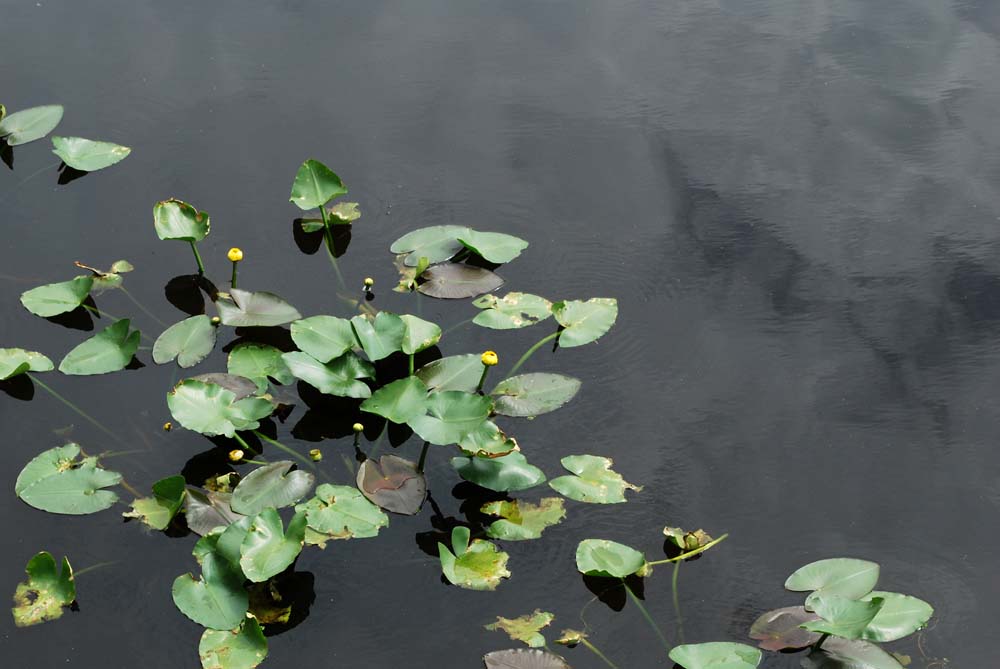Nuphar advena
| Nuphar advena | |
|---|---|

| |
| Photo by Wayne Matchett, SpaceCoastWildflowers.com | |
| Scientific classification | |
| Kingdom: | Plantae |
| Division: | Magnoliophyta - Flowering plants |
| Class: | Magnoliopsida – Dicotyledons |
| Order: | Nymphaeales |
| Family: | Nymphaeaceae |
| Genus: | Nuphar |
| Species: | N. advena |
| Binomial name | |
| Nuphar advena (Aiton) Kartesz & Gandhi | |

| |
| Natural range of Nuphar advena from USDA NRCS Plants Database. | |
Common names: Yellow pond-lily; Spatterdock; Broadleaf pondlily[1]
Contents
Taxonomic notes
Synonyms: Nuphar luteum (Linnaeus) Sibthorp & J.E. Smith ssp. macrophyllum (Small) E.O.Beal; Nuphar fluviatile (R.M. Harper) Standley; Nuphar puteorum Fernald; Nuphar lutea J.E. Smith ssp. advena (Aiton) Kartesz & Gandhi; Nymphaea advena Aiton; Nymphaea chartacea Miller & Standley; Nymphaea fluviatilis R.M. Harper; Nuphar advena ssp. advena.[1]
Varieties: none.[1]
Description
A description of Nuphar advena is provided in The Flora of North America.
Its leaves are 7-30 cm wide, 1.5x long as wide, and rounded lobes. Additionally, the lower leaf surface is glabrous to sparsely pubescent. Any floating leaves have terete petioles and blades that are 1-2× as long as wide. The sepals are red or maroon, while the fruit is green or yellow.[1]
Distribution
N. advena ranges from Maine to Wisconsin, then south to Florida, Cuba, Texas, and northern Mexico.[1]
Ecology
Habitat
N. advena is an aquatic perennial that requires protection from strong current.[2] In the Coastal Plain in Florida, it has been observed growing in ponds of pine-oak forests, ditch ponds, and still river water. Associated species include Brasenia and Nymphaea.[3]
Phenology
This species flowers in May[4] through November and fruits in September.[3]
Typical N. advena fruits are green with green stigmatic disks, anthers, sepals and fruit walls; however, Padgett (1996) reports of a population in southeastern Virginia having red fruit walls. Characteristically this species lacks red pigmentation.
In areas of sympatry, it can intergrade with N. orbiculata, N. variegata, N. ulvacea, and N. sagittifolia.[5]
Pollination
The following Hymenoptera families and species were observed visiting flowers of Nuphar advena at Archbold Biological Station:[6]
Apidae: Apis mellifera
Colletidae: Hylaeus schwarzi
Halictidae: Lasioglossum nelumbonis
Use by animals
It is a food source to some turtles: Chelydra serpentine (snapping turtle), Chrysemys picta (painted turtle), and Stenotherus odoratus (musk turtle).[5] Muskrats and beavers have also been observed to eat the plant, especially the rhizomes and lower petioles.[5]
Conservation, cultivation, and restoration
Cultural use
Photo Gallery
References and notes
Padgett, D. J. (1996). "A Red-Fruited Nuphar advena (Nymphaeaceae) from Virginia." Castanea 61(4): 391-392.
Yoo, M.-J., A. S. Chanderbali, et al. (2010). "Evolutionary trends in the floral transcriptome: insights from one of the basalmost angiosperms, the water lily Nuphar advena (Nymphaeaceae)." The Plant Journal 64(4): 687-698
- ↑ 1.0 1.1 1.2 1.3 1.4 Weakley, A.S. 2015. Flora of the southern and mid-atlantic states. Working Draft of 21 May 2015. University of North Carolina at Chapel Hill, Chapel Hill, North Carolina.
- ↑ [[1]] Illinois Wildflowers Accessed: February 11, 2016
- ↑ 3.0 3.1 Florida State University Robert K. Godfrey Herbarium database. URL: http://herbarium.bio.fsu.edu. Last accessed: October 2015. Collectors: Loran C. Anderson, A.F. Bradley, Robert K. Godfrey, Stacey N. Hensel, Ed Keppner, Lisa Keppner, P. Kral, K.M. Meyer, Richard S. Mitchell, P.L. Redfearn, J. Stone, A. Townesmith. States and Counties: Florida: Bay, Escambia, Gadsden, Jackson, Marion, Okaloosa, Santa Rosa, Washington. Compiled by Tall Timbers Research Station and Land Conservancy.
- ↑ Nelson, G. PanFlora: Plant data for the eastern United States with emphasis on the Southeastern Coastal Plains, Florida, and the Florida Panhandle. www.gilnelson.com/PanFlora/ Accessed: 19 MAY 2021
- ↑ 5.0 5.1 5.2 [[2]] Encyclopedia of Life Accessed: February 10, 2016
- ↑ Deyrup, M.A. and N.D. 2015. Database of observations of Hymenoptera visitations to flowers of plants on Archbold Biological Station, Florida, USA.